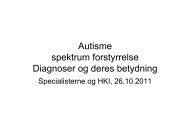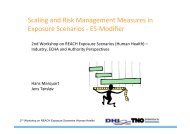11-13 May 2012 Helsingør - Denmark www.networkbio.org
11-13 May 2012 Helsingør - Denmark www.networkbio.org
11-13 May 2012 Helsingør - Denmark www.networkbio.org
Create successful ePaper yourself
Turn your PDF publications into a flip-book with our unique Google optimized e-Paper software.
abStract For SPeakerS<br />
MAREIKE WEIMANN*, JONAThAN WOODSMITh*, ARNDT GROSSMANN, zIYA …zKAN, PETRA BIRTh,<br />
DAVID MEIERhOfER, SASChA SAUER, ULRICh STELzL OTTO-WARBURG LABORATORY, MAx-PLANCK<br />
INSTITUTE fOR MOLECULAR GENETICS (MPIMG)<br />
A Y2H-seq approach to define the protein methyltransferase interactome<br />
Protein methylation, in particular on arginine and lysine residues, is an important, widespread postranslational<br />
modification. The large number of human methyltransferases, potential demethylases and Merecognition<br />
domain containing proteins, which are not only expressed in a large variety of tissues but also at<br />
different subcellular localizations, indicate roles in many cellular processes other than epigenetic regulation.<br />
However, the transient nature of substrate enzyme recognition, the lack of affinity reagents and appropriate<br />
tools to detect methyltransferase substrate pairs largely hampered progress in defining the global role of<br />
non-histone protein methylation.<br />
Here we present a novel proteome wide Y2H protein interaction screening approach involving a second<br />
generation sequencing readout. The method has significantly improved sensitivity in comparison to our state<br />
of the art Y2H matrix screening protocol. Importantly, 2nd generation sequencing provides a quantitative<br />
readout that correlates very well with the retest success rate indicative of the quality of the PPI information.<br />
Y2H-seq will thus accelerate large scale interactome mapping efforts.<br />
We applied the Y2H-seq method to comprehensively screen proteins involved in methylation and demethylation,<br />
i.e. protein methyl transferases (PMTs) and JMJ-domain containing putative demethylases<br />
(PDeMs) such as LSM1, for interacting proteins. We found more than 500 interactions involving 22 PMTs<br />
and PDeMs and 324 potential methylation substrates. Exemplarily, 7 candidate proteins are characterized<br />
with respect to novel R and K methylation sites using a mass spectrometry approach. The final network is<br />
comprehensively annotated, validated in co-IP experiments and will serve as a major informational resource<br />
to define cellular roles of non-histone protein methylation.<br />
abStract For SPeakerS<br />
A.J. MARIAN WALhOUT<br />
UNIVERSITY Of MASSAChUSETTS MEDICAL SChOOL<br />
WORCESTER, MA<br />
A.J. Marian Walhout obtained her BS and PhD degrees in Biochemistry/Medicine<br />
from Utrecht University in the Netherlands. After a post-doc at Harvard<br />
Medical School, she became a Faculty member at the University of Massachusetts<br />
Medical School, Worcester, USA in 2003. She is currently a Professor<br />
in Molecular Medicine and a Co-Director of the Program in Systems Biology.<br />
Gene regulatory networks<br />
Transcriptional regulation of gene expression is pivotal to all biological processes.<br />
Each of our ~20,000 genes must be expressed at the right place, time<br />
and level, and under the right conditions. As a consequence, improper gene expression is associated with<br />
a myriad of human diseases, including congenital disorders, cancer and obesity. The basic mechanisms<br />
of RNA polymerase II transcription have been studied in great detail for decades. However, little is known<br />
about the gene regulatory networks (GRNs) that are composed of physical and regulatory interactions<br />
between transcription factors and their target genes, and that orchestrate spatiotemporal gene expression<br />
during development or upon physiological stresses and pathological insults. Our long-term goal is to comprehensively<br />
characterize the structure, function and evolution of complex metazoan GRNs. As a model we<br />
use the nematode C. elegans, which is amenable to a variety of genetic and genomic approaches. We have<br />
developed a variety of gene-centered methods for the elucidation of GRNs. Progress will be discussed.<br />
26 / INB <strong>2012</strong> • <strong>11</strong>-<strong>13</strong> <strong>May</strong> <strong>2012</strong> <strong>www</strong>.<strong>networkbio</strong>.<strong>org</strong> / 27

















